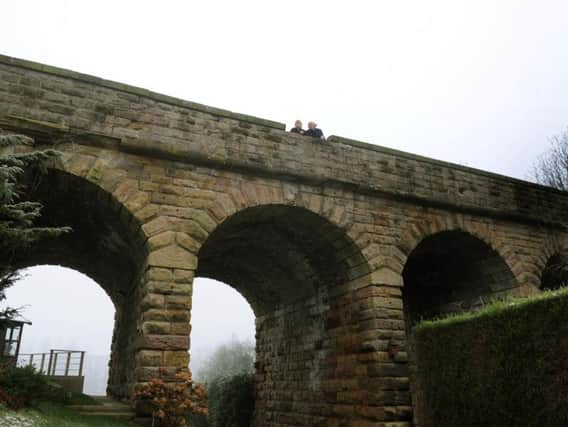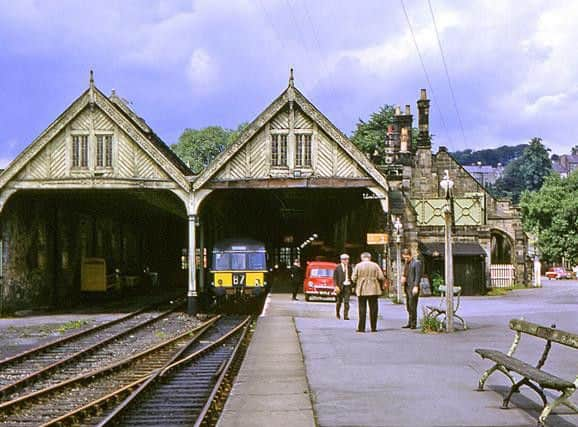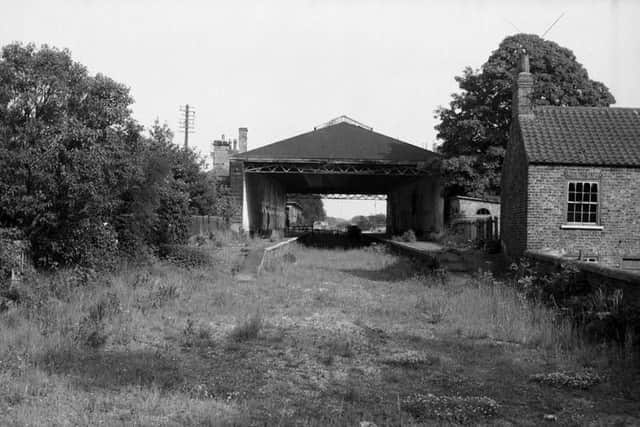This is why most of Yorkshire's closed railways won't re-open under the 'reverse Beeching fund'


Swathes of the rail network were closed during the notorious 'Beeching axe' period, with small branch lines and rural stations particularly badly hit as their routes were thought to be better served by buses.
In Yorkshire, sizeable towns such as Ripon and Wetherby were left without a rail link.
Advertisement
Hide AdAdvertisement
Hide AdLong read: This is why stripping Northern of its franchise won't solve Yorkshire's rail woesThe Conservative government's 'reverse Beeching fund' was first mooted in 2017 by Chris Grayling, who during his tenure as transport secretary invited proposals from local authorities who believed they had a business case to re-open a line.


Shapps is expected to make an announcement this week with further information about the mothballed routes that will receive new investment.
The freight-only line from Newcastle to Ashington via Blyth is expected to open to passenger trains, while a route from Blackpool to Fleetwood is also thought to be one of the forerunners to be reinstated.
But is it feasible to expect lines in Yorkshire to re-open?
The towns that felt the axe swing


Back in the 1960s, Harrogate lost its links to Church Fenton, Ripon and Northallerton, while the line between Ilkley and Otley disappeared, and Otley no longer has a station.
Advertisement
Hide AdAdvertisement
Hide AdWetherby lost its station when the Cross Gates route was shut, and the Scarborough to Whitby line has since become a cycle track.
East Yorkshire towns such as Beverley and Pocklington also lost their link to York.
Not all of the former routes could feasibly re-open - some have become heritage railways, while others have been converted into cycle paths and greenways.
The Skipton to Colne proposal
Reinstating the 12 miles of railway between Skipton and the Lancashire town of Colne has been proposed several times and there's a long-running campaign to secure funding for it.
Advertisement
Hide AdAdvertisement
Hide AdIt wasn't actually a Beeching closure, shutting only in 1970.
At one point, there was a direct through route from Leeds to Liverpool via Skipton. There were three intermediate stations on the stretch between Skipton and Colne.
However, much of the remaining East Lancashire Line is still operational, leading to Skipton to Colne being described as 'the missing link'. Colne is now its eastern terminus, with trains travelling from Blackpool, Burnley, Blackburn and Preston.
Opinion: Should the north's rail routes be improved before HS2 is built?The route has suffered from underinvestment in the past and there are numerous speed restrictions. It's not electrified.
Advertisement
Hide AdAdvertisement
Hide AdSkipton is on the Airedale Line to Bradford, and there are also trains to Leeds and Carlisle.
Campaigners claim there are major economic advantages to reconnecting the two stations, and adding stops along the way at West Craven and Earby.
A 2003 feasibility study found that the route was still intact and that there were no physical obstacles to re-laying track.
In 2018, the government announced that re-opening the line would be re-examined as part of the 'reverse Beeching' policy. In January 2019 it was confirmed that the project was technically feasible, but that its economic benefits still needed to be explored. The demand from freight companies will be assessed in order to determine the scheme's commercial viability.
Advertisement
Hide AdAdvertisement
Hide AdSome of the main beneficiaries would be Skipton Building Society staff - around 1,600 people who work at the company's Skipton head office live in Lancashire.
Cross Gates to Wetherby
Cross Gates Station is still open and has services to Leeds and York - but until 1964, a separate line to Wetherby also terminated at Cross Gates.
There were stations on this line in Scholes, Thorner, Bardsey and Collingham. It was a popular route into Leeds for commuters, and passengers could also reach Scarborough via Wetherby. Special trains ran to Wetherby Racecourse on race days.
Wetherby was also on the small Harrogate to Church Fenton line - there were stations at Thorp Arch and Tadcaster.
Advertisement
Hide AdAdvertisement
Hide AdWetherby was called 'the first lamb to the Beeching slaughter' back in 1963, but there wasn't major opposition to the station's closure at the time. There were only eight passengers using the one daily train on the Church Fenton line, and on the Leeds to Wetherby route, just 10 trains a day operated. There was competition from bus services and there wasn't much freight usage due to other routes being more economical. Most of the freight traffic was coal for domestic use, and demand was declining by the 1960s.
The track was lifted in 1966 and Wetherby Station was demolished in 1971. There were once plans to convert the old lines into relief roads, but they were never realised.
The site is now used as a car park, but original features such as the gate and pedestrian entrance can still be seen.
It is possible to reinstate some parts of both routes, although stretches of former railway land have been built on for housing or converted into cycle paths.
Advertisement
Hide AdAdvertisement
Hide AdThe Cross Gates to Scholes section has been protected from development in case of future reinstatement, although there's never been a serious campaign to bring a scheme to fruition. Part of the original line through Linton and Bardsey has been built over, so re-routing would be necessary. The bridge over the River Wharfe at Collingham has also been demolished.
Harrogate to Ripon and Northallerton
Ripon Station was another high-profile Beeching casualty when it shut in 1967. The current Leeds to Harrogate line had run all the way to Ripon and Northallerton before this section was axed, and the city's relief road was built over much of the original route, although the station building is still standing.
There have been many calls for the line to re-open over the years, but a 2019 campaign by the English Regional Transport Association reignited hopes.
The closure of Ripon Station, leaving the city without rail connections, was vigorously opposed at the time, but Beeching believed that passengers would instead join the East Coast Main Line at York for travel to Northallerton and further north.
Advertisement
Hide AdAdvertisement
Hide AdShould Northern's franchise be split into east and west if the network is nationalised?In 2005, North Yorkshire County Council commissioned a feasibility study into re-opening the line, and in 2015 they included it in their Strategic Transport Prospectus, which was submitted to Transport for the North. However, they've accepted that it won't happen before 2030.
They've estimated the cost of reinstatement as over £40million, but believe it would attract over 2,700 passengers a day.
Another pressure group, the Campaign for Better Transport, have also identified the route as a priority.
Network Rail have supported the idea, as it would mean they could use the track as a diversionary route if there were issues on the East Coast Main Line - this happened during the Thirsk rail crash in 1967, only shortly after the line's closure.
Advertisement
Hide AdAdvertisement
Hide AdOne of those to have actively campaigned for the line to be brought back into use is Dr Adrian Morgan, who founded the Ripon Railway Reinstatement Association in 1987. He also fought successfully to save the Settle to Carlisle line through the Yorkshire Dales from closure.
“Re-opening would knock 55 minutes off the current journey time from Harrogate to the north-east and Scotland. This would probably be without a change of train, as through-trains will happen again in Harrogate instead of having to travel via York and change trains there.
“There is a general need to increase the number of railheads, and railhead car parks and capacity, by reinstating city region commuter rail routes to towns and cities which lost their rail services in the Beeching era. But the real spur will be if the A61 road from Ripon to Harrogate becomes gridlocked in future.”
The track was taken up after closure, but much of the route alignment is still there. Some parts have become farmland and there has been building development at several points.
Advertisement
Hide AdAdvertisement
Hide AdOne bridge over the A61 has been removed and the Ripon bypass was built over part of the eastern stretch. Another part has been turned into a cycle and footpath.
If rebuilt, it would likely be a single-track line.
A new station would have to be sited away from the original station building, which is now a block of flats, and would likely be closer to the city centre.
Ilkey to Otley and Skipton
Ilkley remains an important commuter station with links to Leeds and Bradford, but it also had direct services to Otley and Skipton in the past.
When it first opened, there were two competing routes to Leeds operated by rival companies.
Advertisement
Hide AdAdvertisement
Hide AdThe North Eastern Railway ran into Leeds via Otley and Headingley and the Midland's Leeds to Bradford Railway ran via Guiseley along the Aire Valley. It was the latter which invested more heavily in Ilkley, opening a branch to Shipley and a further extension to Skipton in 1888. Skipton's spur had stations at Addingham, Bolton Abbey and Embsay. Between Ilkley and Otley there were stops at Arthington and Pool-in-Wharfedale.
Beeching closed both the extension line and the NER's route via Otley at the same time, which significantly reduced services to Ilkley. The third and fourth platforms were removed and the track lifted.
Usage had declined after World War Two and never recovered to pre-war levels. By 1957 there were only four trains through Otley each day.
Beeching initially proposed closing all the lines in Wharfedale, but a campaign group succeeded in saving the lines to Guiseley and the section between Burley and Ilkley. The stretches between Burley and Arthington and Ilkley and Skipton were axed.
Advertisement
Hide AdAdvertisement
Hide AdThe Guiseley to Shipley section was also reprieved when Bradford Council agreed to subsidise services.
A small section of the Skipton branch is now part of the preserved Embsay and Bolton Abbey Steam Railway, but most of the route has been redeveloped, and the bridges and embankments were demolished in the 1970s.
The old route of the Ilkley to Otley stretch can still be seen at the foot of the Chevin - there was a large cutting through a sandstone ridge near Milnerwood that is now a footpath.
In January 2019, Campaign for Better Transport released a report identifying the line via Otley as a Priority 2 for re-opening. Priority 2 is for those lines which require further development or a change in circumstances before plans can be advanced.
Advertisement
Hide AdAdvertisement
Hide AdIf the station at Otley re-opened, there would likely be significant commuter flows towards Leeds using the line.
York to Beverley
York and Beverley lost their direct link in the Beeching cuts. The line ran via Market Weighton and Pocklington, and trains could run directly from York to Hull using it. At one point, there was even a Hull to Newcastle service.
Some of the smaller stations closed from the 1930s onwards, but by the 1960s there were still nine trains each way every day. Beeching's report highlighted the line as being unprofitable, as there was an alternative path between York and Hull.
Much of the track-bed, however, still exists, although there has been some building over the route in Pocklington, Stamford Bridge and the outskirts of York. Earthworks and field boundaries provide clues as to where the line ran.
Advertisement
Hide AdAdvertisement
Hide AdThe section between Beverley and Market Weighton has been converted into a cycleway.
There are many old structures still visible and in use, including the Stamford Bridge station house, and the bridge and viaduct over the River Derwent. At Pocklington, the former station is now used by Pocklington School.
A campaign group was set up in 2001 with the aim of re-opening the line, and in 2004 East Riding Council commissioned a feasibility study.
This report found that alterations would be needed to the original alignment - housing development in Huntington and New Earswick would require the connection to the York to Scarborough line to be made further north. New routes that circled the towns of Pocklington and Beverley were proposed.
Advertisement
Hide AdAdvertisement
Hide AdPassenger benefits were thought to outweigh potential interest from freight companies. The report's recommendation was that services ran from Hull via Beverley, Market Weighton, Stamford Bridge and Pocklington with a connection to the York to Scarborough line at Haxby. Two trains per hour were suggested. However, the line wasn't expected to be profitable and would depend on government subsidies.
The idea suffered a setback in 2013, when East Riding Council published a planning document which permitted building on the old line and excluded a reinstatement project, as they thought it would not be realistically deliverable within 20 years.
Scarborough to Whitby
The two coastal resorts haven't been connected by rail since Beeching axed the Scarborough to Whitby line. Popular tourist destinations such as Robin Hood's Bay had their own stations.
Beeching had originally wanted to close Whitby Station and its three lines entirely. There was strong local opposition, and in the end the Esk Valley Line to Middlesbrough was saved as it served villages with steep hills and narrow roads which were unsuitable for buses.
Advertisement
Hide AdAdvertisement
Hide AdThe main line, which had a double track to Pickering and Malton, was axed, but the section to Pickering is now run as a heritage line by the North Yorkshire Moors Railway.
The Scarborough to Whitby line was vulnerable because it was so difficult to work. There were complicated junctions that involved time-consuming train reversals, and steep gradients. The climate meant the rails were often slippery due to mist and rain.
Services were often disrupted in poor weather and were not heavily used outside of the peak summer season.
The track was lifted in 1969, and it is now a cycle path and bridleway called the Cinder Track.
Advertisement
Hide AdAdvertisement
Hide AdIts popularity for leisure use means it's unlikely to re-open as a railway, and there is little demand from commuters - although the route would surely attract tourist traffic.
Richmond
Richmond was the terminus of a small branch line which ran from Eryholme, a junction of the East Coast Main Line between Northallerton and Darlington.
Much of the traffic was military trains serving Catterick Garrison, and a branch was later added to Catterick Bridge.
Beeching signed the line's death warrant, but the Ministry of Defence opposed the closure and there was a brief reprieve until 1970, when the track was lifted.
Advertisement
Hide AdAdvertisement
Hide AdThe station building was saved and it was a garden centre for many years before being converted into an arts and leisure venue.
Most of the track-bed remains and has not been built on, although it is considerably overgrown.
The bridge that carried the Catterick Bridge branch over the A1 at Brompton-on-Swale was lifted when the motorway was widened, and it was purchased by the Wensleydale Railway, who will re-use it to span Apedale Beck on the heritage line.
There hasn't been a major call to reinstate the railway as Richmond was only ever on a minor line which did not reach Darlington Station. However, the original route does connect to the East Coast Main Line, and it would allow Richmond residents to access Darlington and York. Realistically, the ECML is already at peak capacity and Network Rail would be unlikely to encourage additional local traffic alongside express services.